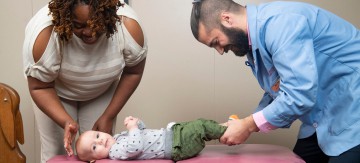[et_pb_section bb_built=”1″ admin_label=”section”][et_pb_row admin_label=”row” background_position=”top_left” background_repeat=”repeat” background_size=”initial”][et_pb_column type=”4_4″][et_pb_text admin_label=”Text” _builder_version=”3.0.49″ background_layout=”light” text_orientation=”center” border_style=”solid”]
What You Might Not Know About the History of Chiropractic Training
[/et_pb_text][et_pb_text admin_label=”Text” _builder_version=”3.0.49″ background_layout=”light” text_orientation=”left” border_style=”solid”]
Hippocrates declared, “Get knowledge of the spine, for this is the requisite for many diseases.” Yet, it wasn’t until the late 19th century that the first chiropractic adjustment was performed, by Daniel David (D.D.) Palmer, in Davenport, Iowa.
The science, art, and philosophy of chiropractic have advanced to where it is seen as an important part of healthcare. Chiropractic has ranked as one of the best career options available and an interest in its non-invasive, holistic benefits has surged.
Here are a few things that you may not already know about chiropractic history.
Chiropractic Founder D.D. Palmer Changed the Future of Health Care
The state of healthcare was much different in the 1890s than today, with patients and practitioners having a limited understanding of health care. The second industrial revolution brought a renewed emphasis on innovation and creativity.
The legendary story of D.D. Palmer healing his janitor’s hearing problems in 1895 by realigning a vertebra, wasn’t the only key factor in the profession’s history. Palmer’s knowledge of the spine’s connectivity to all body systems led him to reason that adjustment of vertebral subluxation could help overall with health. A vertebral subluxation is a condition when a vertebra is out of alignment.
Before formalizing his discovery, Palmer sought further evidence that adjusting subluxation could result in health benefits. He recalled that one patient’s case of heart trouble had not been improving and found a displaced vertebra pressing against the nerves that connected to the heart. An adjustment produced positive results.
“I began to reason if two diseases, so dissimilar as deafness and heart trouble, came from impingement, a pressure on nerves, were not other diseases due to a similar cause?” stated Palmer in his text, The Science, Art, and Philosophy of Chiropractic (1910).This began the science (knowledge) and art (adjusting) of Chiropractic.
Recent studies indicate that chiropractic indeed supports the cardiovascular system by reducing heart rate and lowering blood pressure and anxiety levels. Graduates from an accredited chiropractic program understand that chiropractic care provides a valuable contribution to health and allows the body to self-heal and work at its best.
The Palmers’ Contributions to Chiropractic Training Extend Beyond D.D. and B.J.
After these early successes, D.D. Palmer soon created a school to teach others his methods. Among the first graduates was his son, B.J., who assumed the responsibility of the school within a decade and went on to contribute extensive research and innovation to the burgeoning profession as it expanded throughout the country.
A guiding influence on B.J.’s life was his wife, Mabel Heath Palmer, who became a doctor of chiropractic in 1905. Known as the “first lady of chiropractic,” she was a valued advisor to her husband on all aspects of chiropractic. Mabel even instructed at the Palmer School of Chiropractic for more than 30 years.
D.D., known as the Founder, B.J. as the Developer of chiropractic, and B.J. and Mabel’s son, David, known as the Educator. The grandson of Chiropractic’s founder became president of the school in 1961, modernizing the school, establishing its non-profit status, and organizing its international alumni association over the course of his career. Chiropractic began as a family business!
Chiropractic pioneers, the Palmers and Dr. Lyle Sherman, namesake of Sherman College of Chiropractic, developed many of the foundational principles that students use in daily study and practice. Research continues to confirm that chiropractic’s preventative and natural approach can help patients function closer to their optimal capacity in surprising and fascinating ways.
Interested in serving your community by becoming a doctor of chiropractic?
Sherman College of Chiropractic offers a renowned degree program with full chiropractic accreditation.
[/et_pb_text][/et_pb_column][/et_pb_row][et_pb_row admin_label=”Row” _builder_version=”3.0.49″ background_position_1=”top_left” background_repeat_1=”no-repeat” background_position_2=”top_left” background_repeat_2=”no-repeat” background_position_3=”top_left” background_repeat_3=”no-repeat”][et_pb_column type=”1_3″][et_pb_post_nav admin_label=”Post Navigation” _builder_version=”3.0.49″ in_same_term=”off” hide_prev=”off” hide_next=”on” border_style=”solid” border_color=”#0c71c3″ title_font=”|on|||” title_font_size=”16px” /][/et_pb_column][et_pb_column type=”1_3″][/et_pb_column][et_pb_column type=”1_3″][et_pb_post_nav admin_label=”Post Navigation” _builder_version=”3.0.49″ in_same_term=”off” hide_prev=”on” hide_next=”off” border_style=”solid” border_color=”#0c71c3″ title_font=”|on|||” title_font_size=”16px” /][/et_pb_column][/et_pb_row][/et_pb_section]







